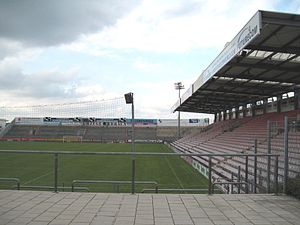Sportpark Unterhaching

View of the north and east stands
|
|
| Former names | Sportpark Unterhaching (1992-2003, 2011-2013), Generali Sportpark (2003-2011) |
|---|---|
| Location | Am Sportpark 9, 82008 Unterhaching, Munich, Germany |
| Coordinates | 48°4′25″N 11°36′56″E / 48.07361°N 11.61556°ECoordinates: 48°4′25″N 11°36′56″E / 48.07361°N 11.61556°E |
| Owner | The Sportpark Unterhaching is owned by the town of Unterhaching |
| Capacity | 15,053 |
| Field size | 105 x 68m |
| Surface | Grass |
| Construction | |
| Built | 1990-92 |
| Opened | 1992 |
| Expanded | 1999-2000 |
| Tenants | |
| SpVgg Unterhaching | |
The Sportpark Unterhaching, currently known as the Alpenbauer Sportpark following a sponsorship deal in 2013, is the home of Munich football club SpVgg Unterhaching. It is used almost exclusively for first-team games and occasionally for reserve-team games. It has a capacity of 15,053 – 6,874 seated and 8,179 standing. The stadium is owned by the town of Unterhaching.
With the club well-established in the 2. Bundesliga, the stadium was constructed in the early 1990s to provide a more suitable home for the team. In 1999, following the unexpected promotion of the team to the Bundesliga, the stadium was expanded and modified to meet the requirements of the German Football Association.
Prior to the stadium expansion, the Sportpark had a capacity of 11,000. The current main stand on the west side of the ground (Haupttribüne, formerly the Westtribüne), with its alpine-style roof, and large parts of the south stand (Südtribüne) were already established, although the current north stand (Nordtribüne) was made up of a few concrete steps and the east stand (Osttribüne) was a grass mound.
Promotion to the Bundesliga in 1999 necessitated improvements in safety, security and capacity, resulting in the current maximum of 15,053.
During first construction phase, prior to season 1999/2000, the capacity of the Nordtribüne – which contains the area for visiting supporters – was significantly increased. In addition, a small standing curve was created in the north-east corner of the stadium. During season 1999/2000, the Nordtribüne was further expanded. After these modifications, the capacity was 10,300; this temporary reduction in capacity was the result of converting standing areas to seating in the Ostribüne.
As a result of the stadium's architecture, development of the Südtribüne (where the clubhouse is situated) and the Haupttribüne (which had an existing roof) was uneconomic. In addition, a VIP house was already situated at the north-west end. Following the successful 1999/2000 season, a curve was constructed between the Südtribüne and Haupttribüne, the Osttribüne was further reinforced and a roof was added, and the Nordtribüne was raised. Following these modifications, the stadium could then fulfill the 15,000 minimum capacity stipulated by the German Football Association.
...
Wikipedia
